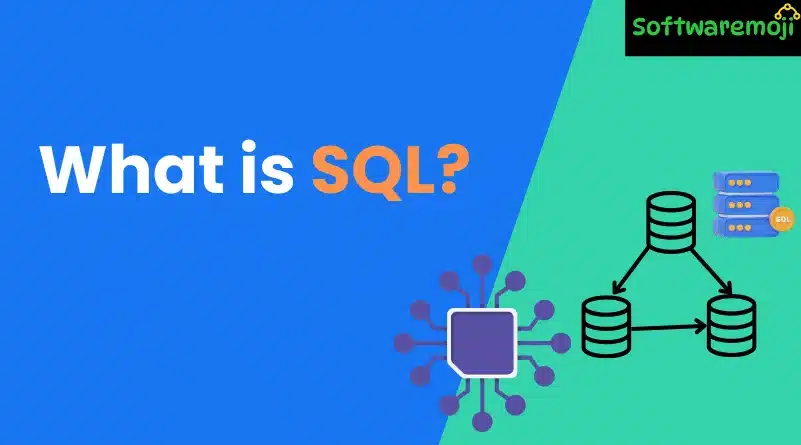
👉What is SQL?
What is SQL: SQL (Structured Query Language) is the standard programming language used to manage and manipulate relational databases. It allows users to insert, update, delete, and retrieve data efficiently. SQL is widely used in database systems like MySQL, PostgreSQL, Microsoft SQL Server, and Oracle.
SQL Full Form & Pronunciation
SQL stands for Structured Query Language and is pronounced as either “S-Q-L” or “See-Quel.” It follows ANSI (American National Standards Institute) standards and is used across various relational database management systems (RDBMS).
👉Why is SQL Important?
What is SQL: SQL is essential for handling structured data in relational databases. It enables users to:
✔ Access and manage data in an RDBMS
✔ Define, modify, and delete data in databases
✔ Create and manage database structures
✔ Use functions, stored procedures, and views
✔ Set permissions for database access
👉Basic SQL Query Example
What is SQL: A simple SQL query to select all members above 30 years of age:
sql
SELECT * FROM Members WHERE Age > 30;
SQL syntax varies slightly between different database systems, but the core commands remain consistent.
👉SQL History & Evolution
- 1970: Dr. Edgar F. Codd introduces the relational model.
- 1974: SQL language is developed.
- 1978: IBM releases System/R, an early relational database prototype.
- 1986: ANSI standardizes SQL.
- 1989 – 2011: SQL evolves with new features like triggers, XML support, and improved database handling.
👉Types of SQL Statements
What is SQL: SQL statements can be categorized into five main types:
1. Data Definition Language (DDL)
Used to define database structures:
- CREATE – Creates tables, databases, indexes
- DROP – Deletes database objects
- ALTER – Modifies tables and databases
2. Data Manipulation Language (DML)
Used to modify data within a database:
- INSERT – Adds new records
- UPDATE – Updates existing data
- DELETE – Removes records
3. Data Query Language (DQL)
Used to retrieve data:
- SELECT – Retrieves data based on specified conditions
4. Data Control Language (DCL)
Used for access control:
- GRANT – Provides user privileges
- REVOKE – Removes user privileges
5. Transaction Control Language (TCL)
Used to manage database transactions:
- COMMIT – Saves changes permanently
- ROLLBACK – Reverts changes in case of errors
👉SQL Commands Cheat Sheet
| Command | Description |
| CREATE | Defines database/table structure |
| INSERT | Adds new records |
| UPDATE | Modifies existing data |
| DELETE | Removes records from a table |
| SELECT | Fetches data based on conditions |
| DROP | Deletes database objects |
👉SQL Process & Execution
What is SQL: When an SQL command is executed, the database management system (DBMS) processes it using:
- SQL Query Engine – Parses and executes the command
- Optimization Engine – Improves query performance
- Query Dispatcher – Distributes workload
- Classic Query Engine – Handles non-SQL queries
👉SQL vs. NoSQL: Key Differences
What is SQL: SQL databases use structured tables and support ACID (Atomicity, Consistency, Isolation, Durability) principles.
NoSQL databases (e.g., MongoDB, Cassandra) use flexible schemas and are optimized for scalability and big data processing.
| Feature | SQL Databases | NoSQL Databases |
| Schema | Fixed Schema | Dynamic Schema |
| Query Language | Uses SQL | Uses JSON, Key-Value, etc. |
| Scalability | Vertical scaling | Horizontal scaling |
| Best For | Structured data | Unstructured/Big Data |
Despite NoSQL’s advantages, SQL remains dominant due to its structured nature, security, and widespread enterprise use.
👉Best Books to Learn SQL
📚 SQL in 10 Minutes – Great for quick learning
📚 SQL Cookbook – Practical SQL techniques
📚 SQL: The Complete Reference – Covers advanced SQL topics
👉Conclusion
SQL is a fundamental skill for database management, data analysis, and web development. Learning SQL helps in managing relational databases efficiently and is crucial for software engineers, data analysts, and database administrators.
Key Takeaways:
✅ SQL stands for Structured Query Language
✅ Used for querying, updating, and managing relational databases
✅ Supports commands like SELECT, INSERT, UPDATE, DELETE
✅ Plays a vital role in enterprise applications and data management
Start learning SQL today and unlock powerful database skills!
Click To Open
👉Tutorial-2: How To Create Data Base
👉Tutorial-3: MYSQL Select Statement
👉Tutorial-4: MYSQL Where Cause
👉Tutorial-5: MYSQL Insert Into Query
👉Tutorial-6: MYSQL Delete Query
